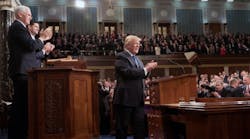Presidential State of the Union addresses are wish lists to begin with, but President Trump's recent SOTU fell short in key areas related to infrastructure, immigration and the declining plumbing.heating/cooling industry workforce, says Mark Copp.
Copp, executive vice president of PHCC-National Association, said in a recent blog that short-term results that favor member contractors and those across the U.S. are unclear.
Following are Copp's comments in full, with footnotes for certain points:
Infrastructure: PHCC continues to emphasize with the White House that infrastructure investment is as much about upgrading components below ground as it is about above ground (highways, roads, and bridges). According to the American Water Works Association, “upgrading existing water systems and meeting the drinking water infrastructure needs of a growing population will require at least $1 trillion.”1. Congress will soon consider appropriation legislation to fund large infrastructure projects including public/private partnerships and PHCC National will continue to engage Congress and the Administration about considering water and waste water infrastructure—which by the way is co-mingled with aviation, bridges, dams, energy, hazardous waste, inland waterways, levees, ports, public parks, rail, roads, schools, solid waste and transit. You can see there are many competing infrastructure priorities and the President’s proposed $1.5 trillion building program will certainly not be nearly enough.
Immigration: PHCC noted back in 2007 that the construction industry continues to face a critical shortage of skilled labor and that some of this insufficiency is being addressed by the immigrant workforce. However, PHCC also believed that immigration policies have to be strengthened to ensure that U.S. workers are not displaced by foreign workers. While these two needs appear to contradict each other, the distinction that PHCC promotes is its desire for a guest worker visa program for hardworking, taxpaying, undocumented workers versus those undocumented immigrants that are not employed, not actively pursuing employment, and engaging in illicit activity. The first approach that could achieve this is looking hard at the Deferred Action for Childhood Arrivals (DACA) program and the Development, Relief, and Education for Alien Minors (DREAM) Act, which did not pass, but whose acronym now carries a broader context.
DACA and the DREAM Act are a primary area of the immigration reform debate that President Trump did not fully address. The DACA program gives work permits and protections from deportation to children of illegal immigrants already in the U.S., as opposed to the DREAM Act, which would have provided legal status to some undocumented immigrants who came to the United States as children and attended school. Instead, the president talked about extending an “open hand” by “giving 1.8 million young immigrants a path to citizenship, creating a $25 billion trust fund to build a border wall, ending rules allowing legal immigrants to bring their families to the country, and shutting down a lottery program aimed at encouraging immigration from underrepresented countries.”2
Initially, if one ties the concept of a “path to citizenship“ to “guest worker visa program,” then that could be the start of addressing PHCC’s desire to in part, permit hardworking, taxpaying, undocumented workers to earn legal status. Wages for legal guest workers should be determined by the most prevalent data available and comparable to wages for native employees performing the same or similar work.
Workforce Shortage: As Michael Stratford wrote in his Jan. 31, 2018 article, Trump pitches boost to vocational education, “President Trump… called on Congress to ‘invest in workforce development and job training’ and ‘open great vocational schools.’ ”3 PHCC has advocated heavily on the need to bring vocational classes back to the high schools in order to develop a career pathway to the trades. However, President Trump’s “fiscal 2018 budget request proposed slashing federal spending on career and technical education by more than $1 billion.” Furthermore, schools represent only one of 16 infrastructure needs for which spending is required, but for which he has proposed only a $1.5 trillion building program for “gleaming new roads, bridges, highways, railways, and waterways across our land.” Aside from this, PHCC continues to monitor the work of the U.S. Department of Labor Task Force on Apprenticeship Expansion, which is looking at “strategies and proposals to promote apprenticeships, especially in sectors where apprenticeship programs are insufficient.”4
________
1. Retrieved on the World Wide Web on Feb. 1, 2018 at https://www.infrastructurereportcard.org/cat-item/drinking-water/
2. Michael D. Shear and Peter Bakerjan (January 31, 2018), Trump’s Speech Leaves Two Sides Further Apart Than Ever on Immigration, The New York Times
3. Retrieved on the World Wide Web on Feb. 1, 2018 at https://www.politico.com/newsletters/morning-education/2018/01/31/trump-pitches-boost-to-vocational-education-088655.
4. Retrieved on Feb. 2, 2018 at https://www.dol.gov/apprenticeship/task-force.htm









